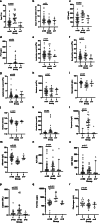Distinctive Features of Kawasaki Disease Following SARS-CoV-2 Infection: a Controlled Study in Paris, France
- PMID: 33394320
- PMCID: PMC7780601
- DOI: 10.1007/s10875-020-00941-0
Distinctive Features of Kawasaki Disease Following SARS-CoV-2 Infection: a Controlled Study in Paris, France
Abstract
Background: An outbreak of multisystem inflammatory syndrome in children, including Kawasaki disease (KD), emerged during COVID-19 pandemic. We explored whether Kawasaki-like disease (KD), when associated with confirmed SARS-CoV-2 infection, has specific characteristics.
Methods: We included children and adolescents with KD criteria admitted in the department of general pediatrics of a university hospital in Paris, France, between January 1, 2018, and May 26, 2020. The incidence of KD was compared between the outbreak and a pre-outbreak control period (January 1, 2018, to April 25). Characteristics of patients with positive SARS-CoV-2 testing (KD-SARS-CoV-2) were compared to those of the pre-outbreak period (classic KD).
Results: A total of 30 and 59 children with KD were admitted during the outbreak and pre-outbreak periods, respectively (incidence ratio 13.2 [8.3-21.0]). During the outbreak, 23/30 (77%) children were diagnosed as KD-SARS-CoV-2. When compared with patients with classic KD, those with KD-SARS-CoV-2 were more frequently of sub-Saharan African ancestry (OR 4.4 [1.6-12.6]) and older (median 8.2 vs. 4.0 years, p < 0.001), had more often initial gastrointestinal (OR 84 [4.9-1456]) and neurological (OR 7.3 [1.9-27.7] manifestations, and shock syndrome (OR 13.7 [4.2-45.1]). They had significantly higher CRP and ferritin levels. Noticeably, they had more frequently myocarditis (OR 387 [38-3933]).
Conclusions: Children and adolescents with KD-SARS-CoV-2 have specific features when compared with those with classic KD. These findings should raise awareness and facilitate the study of their pathogenesis.
Keywords: COVID-19; Kawasaki disease; MIS-C; PIMS-TS; SARS-CoV-2.
Figures


References
-
- Coronavirus disease WHO. (COVID-19) situation report–77. Geneva. Switzerland: World Health Organization; 2019. p. 2020.
-
- Fontanet A, Tondeur L, Madec L, et al. Cluster of COVID-19 in northern France: a retrospective closed cohort study. medRxiv 2020;10.1101/2020.04.18.20071134 [Preprint].
-
- Castagnoli R, Votto M, Licari A, et al. Severe acute respiratory syndrome coronavirus 2 (SARS-CoV-2) infection in children and adolescents: a systematic review. JAMA Pediatr. 2020. 10.1001/jamapediatrics.2020.1467. - PubMed
-
- Gudbjartsson DF, Helgason A, Jonsson H, Magnusson OT, Melsted P, Norddahl GL, Saemundsdottir J, Sigurdsson A, Sulem P, Agustsdottir AB, Eiriksdottir B, Fridriksdottir R, Gardarsdottir EE, Georgsson G, Gretarsdottir OS, Gudmundsson KR, Gunnarsdottir TR, Gylfason A, Holm H, Jensson BO, Jonasdottir A, Jonsson F, Josefsdottir KS, Kristjansson T, Magnusdottir DN, le Roux L, Sigmundsdottir G, Sveinbjornsson G, Sveinsdottir KE, Sveinsdottir M, Thorarensen EA, Thorbjornsson B, Löve A, Masson G, Jonsdottir I, Möller AD, Gudnason T, Kristinsson KG, Thorsteinsdottir U, Stefansson K. Spread of SARS-CoV-2 in the Icelandic population. N Engl J Med. 2020;382(24):2302–2315. doi: 10.1056/NEJMoa2006100. - DOI - PMC - PubMed
MeSH terms
LinkOut - more resources
Full Text Sources
Other Literature Sources
Medical
Research Materials
Miscellaneous

